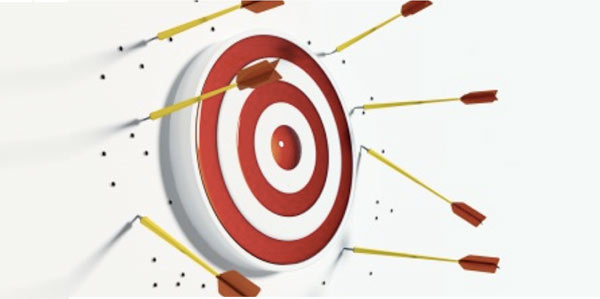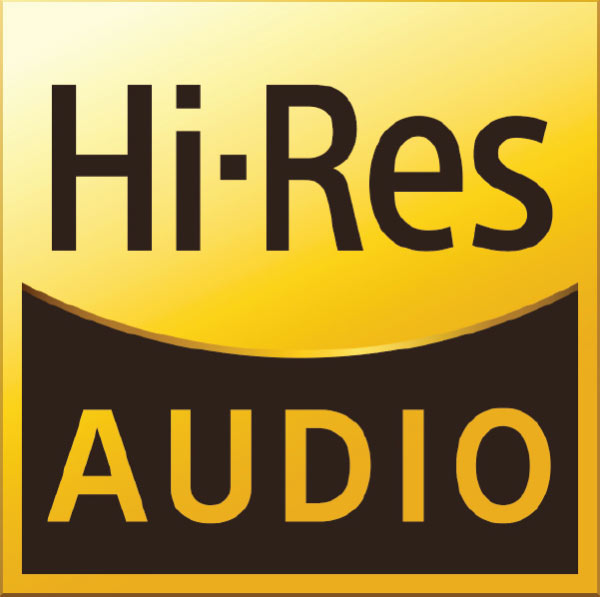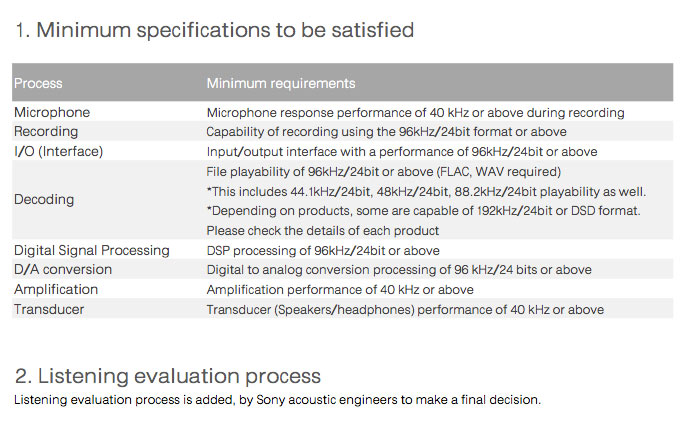CEA and JAS Collaborate on Hi-Res Audio Promotion
The Consumer Electronics Association and the Japan Audio Society “announced a new partnership to help promote and support the marketplace growth of High-Resolution Audio (Hi-Res Audio or HRA) devices and content.” The press release, issued December 18th, focuses on expanding the use of the HRA logo, which was originally developed by Sony and then granted to the JAS to administer. The logo has been in use for over a year by Japanese companies but this new collaboration will bring the logo to the U.S. and members of the CEA. According to the press release, “CEA also has agreed to utilize and promote the logo to its members and consumers.”
Figure 1 – The “universal” logo for “high-resolution audio”.
Hardware and content companies will be able to license the Hi-Res Logo for use with their products in packaging, advertising, marketing, and merchandising if they “agree to follow the HRA product guidelines and performance requirements, as specified by JAS.” Those guidelines and performance requirements were discussed in a previous post and are summarized in the following figure:
Figure 2 – The JAS chart showing the minimum specifications that must be met to qualify for a license to use the Hi-Res Audio Logo. [Click to enlarge]
The biggest thing to note is the move from 20 kHz to 40 kHz in the microphones and transducers (headphones and speakers). The 96 khZ/24-bit PCM specification gets us all of the fidelity we want and really is the minimum for real high-resolution recording and delivery. Sadly SACD and DSD 64 don’t qualify because of the frequency range limitation…DSD 64 gets very noisy after about 23 kHz.
The press release continues with the usual statements about how thrilled the CEA is to work with the JAS to “help establish consistency and assist consumers in navigating this exciting, steadily emerging market.”
That’s the key term in the whole document…consistency! Unfortunately, the CEA doesn’t seem to fully understand the meaning of consistency. As the document continues, they blow a huge hole in the whole notion consistency. It’s one thing to have common logo but quite another to have it apply to two completely incompatible definitions of what high-resolution audio actually is. Am I the only one that see the contradiction?
The JAS organization is collaborating with the CEA to bring the logo AND “the guidelines and performance requirements”. However, the CEA’s definition of HRA doesn’t meet them…by a long shot! The press release continues with a reiteration of the “formal definition for HRA”, which was hammered out by the DEG, CEA, The Recording Academy in partnership with Sony Music Entertainment, Universal Music Group, and Warner Music Group. Here’s how that group defines high-resolution audio:
“The organizations and companies agreed to define HRA as lossless audio that is capable of reproducing the full range of sound from recordings that have been mastered from better than CD quality music sources. Separate from this definition, the organizations also agreed to designate four different Master Quality Recording categories, each of which describes a recording that has been made from the best quality music source currently available. All of these recordings sound like the artists, producers and engineers originally intended.”
This definition is not a set of guidelines. It doesn’t set standards for performance quality. It lacks any teeth and allows virtually every recording ever produced to qualify as HRA. After all, what is the “best quality music source currently available?” Really.
An Edison cylinder (an analog recording made at the turn of the 20th century) of a wire recording made in the 30s would be classed under the Master Quality – Analog (MQ-A) and if transferred to a 96 kHz/24-bit PCM bit bucket would be considered High-Resolution Audio tracks. But they obviously wouldn’t qualify for the Hi-Res Logo, which demands the microphones and the entire production path be capable of handling 40 kHz (we’re not going to argue whether you can hear it or not. How does the CEA square this contradiction? How will the logo be distributed to companies whose products meet the lesser of the two standards? Will a manufacturer of turntables be allowed to license the JAS logo? How about a super resolution audio download site that provides DSD files transferred from analog tapes?
All of this in the interest of “consistency” and to avoid confusion in the emerging high-resolution audio marketplace. We’re not off to a very good start.
For a little history on this topic…read these posts: Post 1 or Post 2.
+++++++++++++++++++
I’m still looking to raise the $3700 needed to fund a booth at the 2015 International CES. I’ve received some very generous contributions but still need to raise additional funds (I’ve received about $3000 so far). Please consider contributing any amount. I write these posts everyday in the hopes that readers will benefit from my network, knowledge and experience. I hope you consider them worth a few dollars. You can get additional information at my post of December 2, 2014. Thanks.




There still needs to be a spec to discern the difference between recorded in HiRes verses a “Transfer” to/from HiRes. Otherwise, as it was so well put at the TC-HRA meeting at the LA Convention in October, “even an Edison wax cylinder could cleaned-up, up-converted and then be called HiRes”. Sorry, but that just wouldn’t cut-it with me or others. There has to be some designator labeling spec regarding that, for such a spec to fly right.
Exactly…I’ve proposed a series of logos for the provenance of a production.
I had a simple design back in 2007 after returning from the London, AES conference at QMUL. I have it stashed and would pull out in the future, on the off chance someone might be interested. And I needed to get some practice on my CAD software, was feeling that rusty that week.
Hi Mark,
I like the fact that the minimum requirements of the JAS chart are consistent and draw a clear line based on facts. Nevertheless, I can’t imagine many different recording and playback chains that can meet the minimum requirements.
You have insisted on the fact that these minimum requirements also apply to manufacturers of equipment, who would necessarily have to step up their game, but I can’t help but to ask if it’s possible – under the current state of technology and physical limitations of materials available – to improve transducers much further.
I know there are a few omnidirectional microphones – like the DPA 4004s or the Earthworks QTC40/50s – that meet the 40 kHz requirements, and since you use pairs of omnis for each instrument, you coud be pretty covered, but what about the rest of the mics available, preeamps, and D/A and A/D converters?
Could you give at least 3 examples of current and entire recording and playback chains that meet the minimum requirements of the JAS chart?
Cheers!
You’ll notice a whole bunch of CE companies starting to marketing Hi-Res Audio products. Even the cheap speakers ($159 each) we used in the research study claimed response to 40 kHz. Microphones…no problem. They may be down somewhat at 40 kHz but they do get there…some better than others. Preamps…also not problem. Avalon, Benchmark, Millenia etc all make it. The analog path is fine to 100 kHz…if people choose to leave it alone. Real HD-Audio will be rare…as it should be.
It is good Mark that you can attend the conventions and association meetings and raise the inconsistencies. As far as provenance is concerned, what I just read on an early stereo vinyl may make you smile : “This recording was made on Ampex 350-2 with special electronic circuitry, using Altec, Electrovoice, RCA and Telefunken microphones. The masters were cut with an automatic Scully Record Lathe mounting a Westrex 45-45 cutter with special feedback electronic circuitry driven by custom 200 watt amplifiers. While the total frequency range of 16 cps to 25,000 cps on this record may not be within the range of ordinary human hearing, nevertheless inspection of the grooves with a microscope will show the etchings of the upper dynamic frequencies.”
Thanks very interesting…the tone of audiophile writing has always been the same.